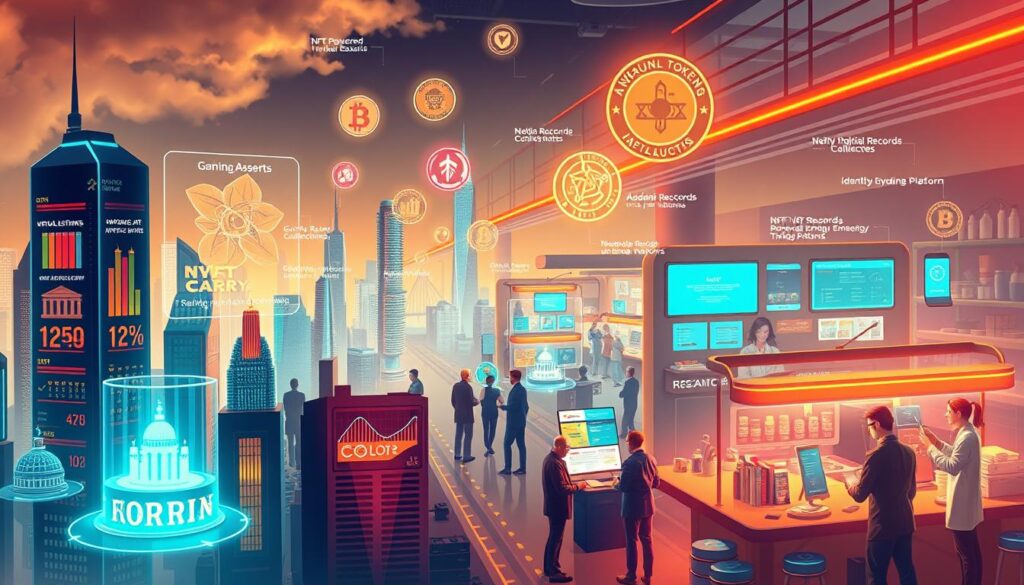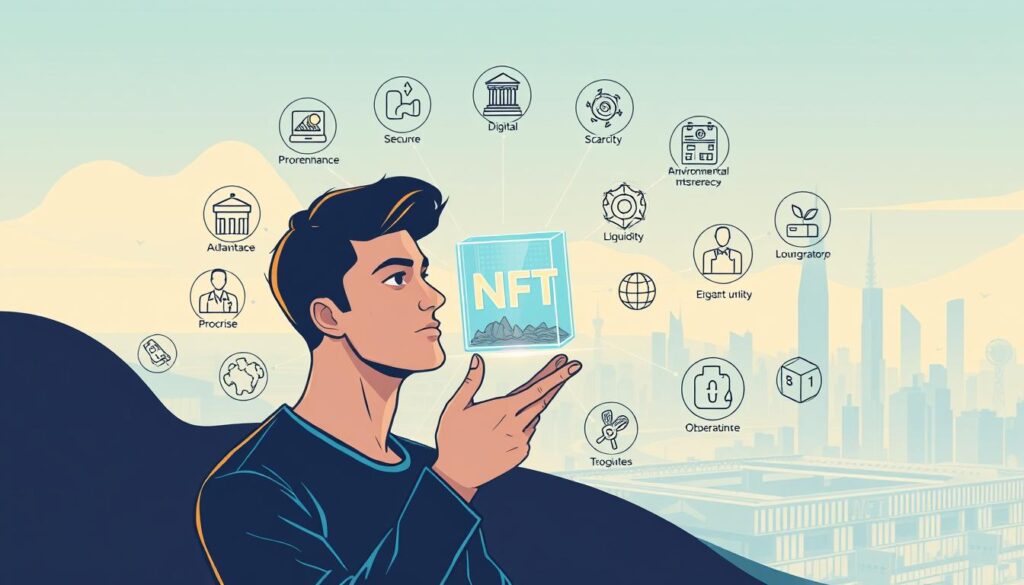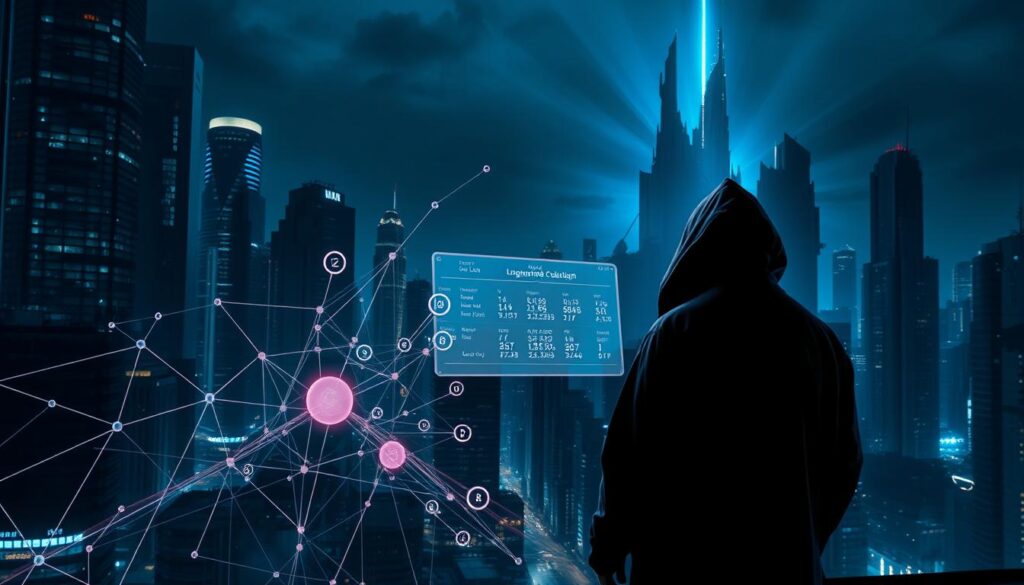Now Reading: Understanding Non fungible token digital ownership
- 01
Understanding Non fungible token digital ownership
Understanding Non fungible token digital ownership

The landscape of asset possession is undergoing a profound transformation. This guide explores a revolutionary technology that is reshaping how we establish and verify control over unique items.
At its core, this innovation moves us away from traditional paper-based deeds and certificates. It leverages a secure, public ledger known as a blockchain to provide undeniable proof of who holds the rights to a specific asset.
This system is particularly powerful for creators and businesses. It offers new ways to protect and monetise unique creations in the digital space. NFTs (non-fungible tokens) have become essential tools for this purpose.
Our exploration will cover the technical foundations that make this possible. We will also examine the real-world applications and the challenges that accompany this exciting new frontier.
Key Takeaways
- This technology represents a fundamental shift from traditional models of proving possession.
- It utilises blockchain networks to create a transparent and unchangeable record.
- Creators and enterprises are using it to safeguard and profit from their unique digital assets.
- The system relies on smart contracts and cryptographic methods for security.
- New opportunities are emerging across various industries, including art and gaming.
- Adoption also presents challenges, such as environmental considerations and market liquidity.
- This guide aims to provide a balanced and informative understanding of the subject.
Introduction to Non fungible token digital ownership
A groundbreaking development in the world of digital commerce is revolutionising how we prove control over distinctive assets. This innovation centres around unique cryptographic items that serve as certificates for exclusive rights.
Defining NFTs and Digital Ownership
These special cryptographic items represent exclusive control over both virtual and physical objects. Unlike interchangeable currencies like Bitcoin, each unit possesses a unique signature that makes it irreplaceable.
They function as verifiable certificates indicating authenticity and rights. Each unit contains distinctive identity information stored on an unchangeable ledger.
Overview of Blockchain Technology
The underlying technology providing security is a distributed ledger system. This network creates transparent records that cannot be altered or duplicated.
Cryptographic encryption and decentralised validation ensure permanent ownership history. Technical standards like ERC-721 govern how rights are transferred between parties.
This system eliminates the need for centralised intermediaries. It solves long-standing problems of provenance verification for unique items.
The Evolution of NFTs and Digital Assets
Early pioneers in blockchain technology laid the foundation for today’s vibrant ecosystem of unique digital items. The first significant milestone occurred in 2014 when Kevin McKoy created “Quantum” on the Namecoin blockchain.
This early experiment demonstrated the potential for verifiable uniqueness on distributed ledgers. It established core principles that would later drive the entire market.
From CryptoKitties to Modern Digital Collectibles
The real breakthrough came in November 2017 with CryptoKitties. This game allowed users to collect, breed, and trade unique virtual cats on the Ethereum blockchain.
Each CryptoKitty possessed distinctive “cattributes” determined by its blockchain identifier. Collectors quickly recognised the value of rare traits, spending millions in ether within weeks.
This phenomenon demonstrated the economic potential of scarce digital items. It showed how blockchain technology could create genuine market demand for virtual possessions.
The same year saw Decentraland launch its virtual real estate platform. Participants could buy and sell parcels of land in this blockchain-based open world.
Premium locations commanded higher prices, mirroring real-world property markets. This expansion beyond simple collectibles showed the technology’s versatility.
Technical standards evolved rapidly to support this growth. The ERC-1155 protocol improved efficiency by batching multiple items into single contracts.
This reduced transaction costs while maintaining the uniqueness of each asset. The progression from experimental projects to sophisticated applications happened remarkably fast.
Blockchain Technology and Smart Contracts
Secure verification of exclusive rights depends on innovative ledger technology and self-executing agreements. These systems work together to create tamper-proof records that cannot be altered or duplicated.

How Blockchain Secures NFT Ownership
The creation process, called minting, involves encrypting asset information onto the blockchain. Validators verify this data before sealing it permanently in a new block.
This distributed architecture ensures that records remain transparent and publicly verifiable. The technology prevents unauthorised changes through cryptographic encryption.
Role of Smart Contracts in Automating Transactions
These programmable agreements automatically enforce rules when specific conditions are met. They manage transfers and execute complex behaviours without manual intervention.
For example, smart contracts can automate royalty payments to creators on secondary sales. They also handle membership access and conditional transfers based on predefined criteria.
The automation reduces friction in transactions by eliminating manual processes. Once a sale completes, the blockchain handles all subsequent steps automatically.
Core Principles Behind Non-Fungible Tokens
Understanding the fundamental mechanics requires examining several key characteristics that distinguish these assets. Each unit contains a unique identifier that sets it apart from all others.
This individuality remains even when multiple items represent similar content. Like numbered tickets to an event, each maintains its distinct identity.

Digital scarcity drives much of the perceived value in this ecosystem. Limited supply creates economic worth that was previously difficult to establish for virtual items.
These assets function like digital passports with non-transferable identities. Their metadata creates permanent links to blockchain records that verify provenance.
The concept of extensibility allows creative combinations. Two assets can merge to form a third, entirely new item with inherited traits.
| Characteristic | Fungible Assets | Non-Fungible Assets |
|---|---|---|
| Interchangeability | Identical units are interchangeable | Each unit is completely unique |
| Divisibility | Can be divided into smaller units | Exist as whole items only |
| Value Determination | Market supply and demand | Uniqueness, rarity, and provenance |
| Ownership Verification | Balance-based accounting | Unique identifier tracking |
| Use Cases | Currency, reward points | Art, collectibles, unique rights |
Public verifiability lets anyone confirm ownership and transaction history. This transparency occurs without needing special permission or intermediaries.
The irreplaceable nature makes these items suitable for representing unique rights and experiences. This fundamental difference from interchangeable assets creates new possibilities.
Applications of NFTs in Various Industries
The practical implementation of unique cryptographic assets is revolutionising business models across multiple sectors. These innovative certificates create new opportunities for engagement and monetisation.

Creative fields have embraced this technology most visibly. Artists and musicians find novel ways to connect with audiences and control their work.
Digital Art, Music and Creative Content
Visual creators tokenise their digital art to sell directly to collectors. This approach establishes clear provenance and enables ongoing royalty earnings.
Musicians release limited edition recordings and exclusive content as unique assets. These NFTs create direct fan relationships beyond traditional streaming.
Photographers offer fractional ownership of their work. Sports personalities launch digital collectibles with interactive fan experiences.
Gaming, Virtual Real Estate and Beyond
Video games incorporate unique assets representing weapons, characters, and land parcels. Players truly own these items and can trade them across platforms.
Virtual real estate platforms like Decentraland allow users to purchase and develop digital property. Location-based value mirrors physical property markets.
Fashion brands create authenticated digital twins linked to physical products. Enterprises develop loyalty programmes using unique cryptographic certificates.
| Industry | Primary Application | Key Benefit |
|---|---|---|
| Art & Music | Direct creator-collector sales | Ongoing royalty streams |
| Gaming | Ownable in-game assets | Cross-platform trading |
| Virtual Real Estate | Digital land ownership | Location-based value |
| Fashion & Retail | Product authentication | Enhanced brand engagement |
| Enterprise | Membership programmes | Customer loyalty enhancement |
These diverse applications demonstrate the technology’s flexibility. Businesses continue discovering innovative way to leverage unique cryptographic assets.
Benefits and Challenges of NFT Digital Ownership
Evaluating the practical implications of cryptographic assets reveals a complex landscape of benefits and obstacles. This technology offers innovative solutions while presenting important considerations for users.
Advantages for Creators and Collectors
These unique certificates provide direct market access for artists and creators. They eliminate intermediaries, allowing creators to connect straight with their audience.
Smart contracts automate royalty payments on secondary sales. This ensures ongoing compensation for original creators without manual tracking.
Fractional ownership opens investment opportunities to more people. Multiple collectors can share ownership of high-value assets that were previously inaccessible.

Key Considerations and Risks
The market for these assets shows volatility and limited liquidity. Prices can fluctuate significantly, creating risks for investors.
Environmental concerns arise from the energy required for blockchain operations. The industry continues developing more sustainable solutions.
Regulatory uncertainty presents challenges for legal protection. Clear frameworks are still emerging around intellectual property rights.
While the certificates prove ownership, the underlying content can still be copied. However, such copies lack the authentic verification that gives these items their value.
Real-World Examples and Enterprise Use Cases
Enterprise adoption of blockchain-based certificates is demonstrating practical value beyond initial creative applications. Companies are discovering innovative ways to leverage these technologies for customer engagement and operational efficiency.
Case Studies in Digital Membership Programmes
Kaleido has helped businesses create membership systems using nfts. These programmes offer secure, tamper-proof access with automated renewals. They provide exclusive perks that enhance customer loyalty.
Major nft marketplace platforms like OpenSea and Magic Eden facilitate diverse sales. These platforms host categories from art and music to virtual worlds. Collectors can find unique assets across various interests.
Entertainment industry implementations show artists using nfts to sell exclusive content. Sports organisations create digital trading cards and fan experiences. These initiatives generate new revenue streams while deepening engagement.
Financial institutions explore nfts for secure identity verification. Retail brands develop loyalty programmes using tokenised rewards. Ernst & Young’s fine wine solution demonstrates authentication for physical luxury assets.
This example of using nfts shows how tokens solve real-world challenges. Businesses benefit from enhanced customer relationships and reduced fraud. The technology continues to find practical applications across sectors.
Future Trends in NFT and Digital Collectibles Markets
The trajectory of unique cryptographic assets reveals evolving patterns of adoption and technological refinement. Market dynamics continue to shift toward practical utility rather than pure speculation.
Technical standards like ERC-1155 demonstrate significant efficiency improvements. They batch multiple items into single contracts, reducing transaction costs and environmental impact.
Emerging Technologies and Regulatory Outlook
Multi-chain ecosystems expand beyond Ethereum, increasing accessibility and addressing scalability concerns. Different blockchain networks now support their own protocols for these assets.
Social media platforms experimented with integration, though results varied. Reddit maintains support while X removed features as interest fluctuated.
Regulatory frameworks gradually emerge worldwide. Governments address taxation, intellectual property, and consumer protection terms.
This clarity could catalyse institutional adoption by providing legal certainty. Cross-border transactions and dispute resolution mechanisms would benefit.
Future applications may extend beyond current collectibles and artwork. Supply chain verification and decentralised identity systems represent promising directions.
For those interested in specific collecting strategies, our guide to NFTs for art collectors offers detailed insights. The technology continues evolving toward broader real-world utility.
Conclusion
As we conclude our exploration, it becomes clear that cryptographic assets offer transformative potential beyond initial market speculation. These unique certificates represent more than just digital collectibles—they serve as versatile tools enabling new forms of creativity and commerce.
The technology addresses long-standing challenges around provenance and creator compensation. From art and music to gaming and enterprise applications, diverse platforms demonstrate practical utility. This article has shown how artists and businesses leverage these assets in innovative ways.
While challenges around regulation and market stability persist, the fundamental value proposition remains strong. As the technology matures, we can expect broader adoption across supply chains and identity management systems.
Understanding this evolving concept is essential for navigating today’s digital economy. The journey of blockchain-based certificates continues to redefine how we approach verifiable ownership and authentic content.
FAQ
What is the main difference between an NFT and a cryptocurrency like Bitcoin?
The key distinction lies in fungibility. Cryptocurrencies such as Bitcoin are fungible, meaning each unit is identical and interchangeable. An NFT, however, is unique and cannot be exchanged on a one-to-one basis. Each token represents a specific digital asset, like a piece of artwork or a collectible, making it non-fungible.
How does blockchain technology prove I own an NFT?
Blockchain provides a public, tamper-proof ledger. When you purchase an NFT, a record of the transaction is permanently added to the blockchain. This record, visible to anyone, confirms you as the current owner. The smart contract associated with the NFT enforces these ownership rights, creating a verifiable and secure proof of ownership.
Can I use NFTs for things other than digital art?
Absolutely. While digital art is a prominent application, the technology has far-reaching uses. These include tokenising music albums, granting access to exclusive content, representing virtual real estate in metaverse platforms, verifying the authenticity of luxury goods, and even managing tickets for events as unique digital collectibles.
What are the risks associated with buying NFTs?
Potential risks include market volatility, where the value of an asset can fluctuate significantly. There is also the possibility of purchasing counterfeit or stolen works if proper verification is not conducted. Additionally, the environmental impact of some blockchain networks and the evolving regulatory landscape are important considerations for collectors and creators.
Where can I buy and sell these tokens?
Transactions typically occur on specialised online platforms known as NFT marketplaces. Popular examples include OpenSea, Rarible, and Foundation. These platforms connect creators with collectors and facilitate the minting, listing, buying, and selling of tokens using cryptocurrency.
Do I own the copyright to the artwork when I buy an NFT?
Generally, no. Purchasing an NFT usually grants you ownership of that specific, tokenised version of the asset, not the underlying intellectual property rights. The creator typically retains the copyright, meaning you cannot reproduce or commercially exploit the work without their permission. Always check the terms specified in the smart contract.














